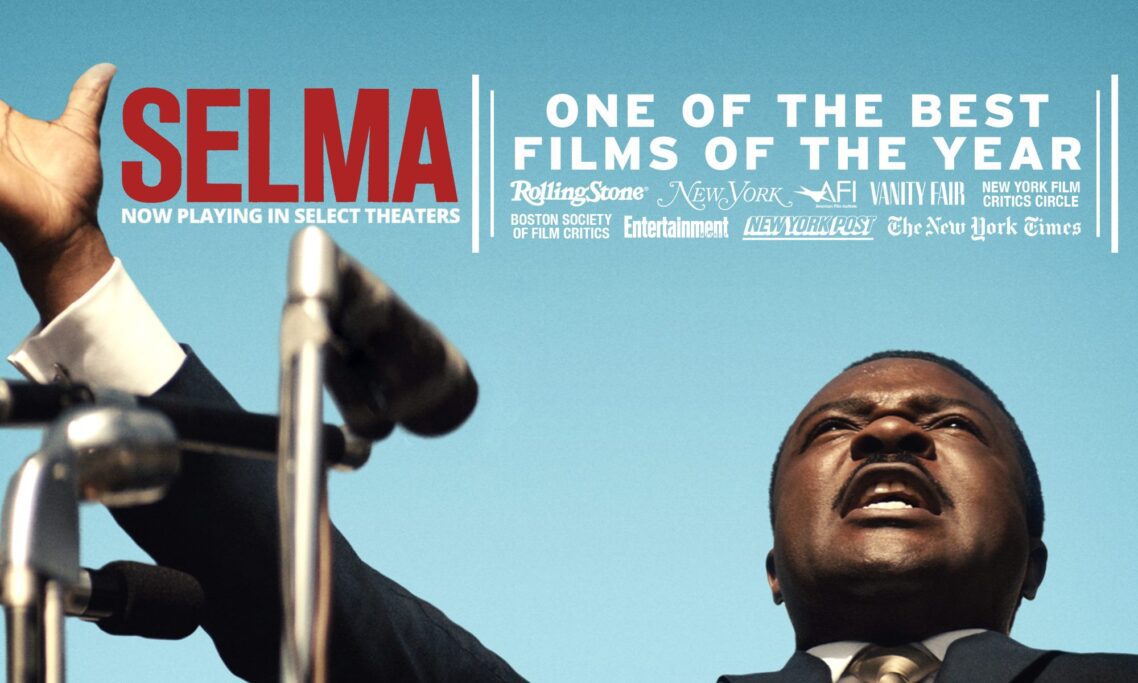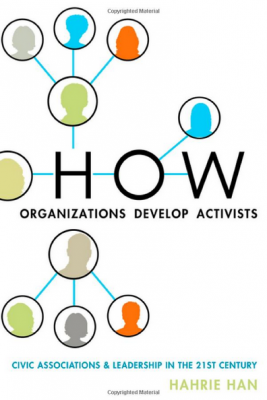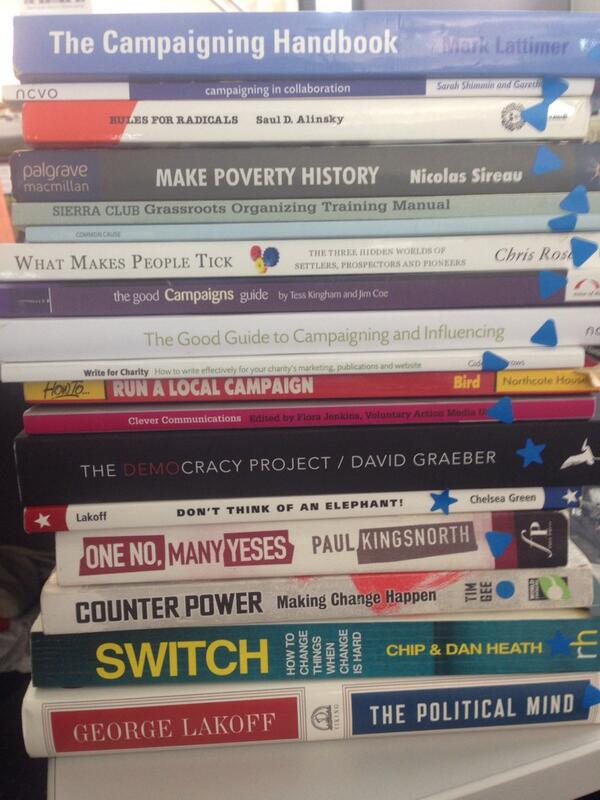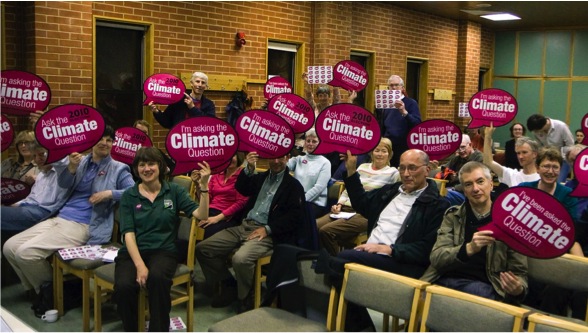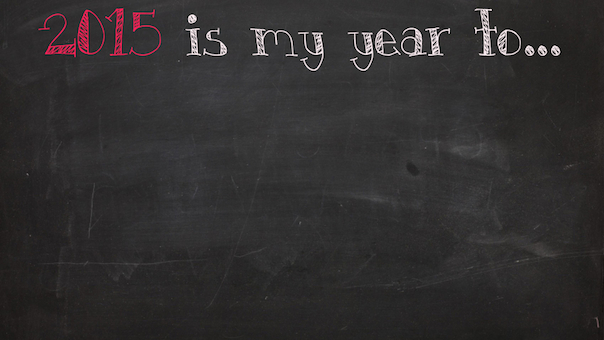If you take nothing else from this post. Go see the movie Selma.
I promise you its the most powerful film you’ll see this year, and a ‘must watch’ for anyone interested in how change happens.
Much has been written about Martin Luther King and the Civil Rights Movement, but walking out from seeing Selma I was struck by a few lessons that should resonate for all campaigners;
1 – You can’t go alone – The film centres on the leadership of Martin Luther King, played brilliant by David Oyelowo, but throughout the film you see the importance of the role of the other leaders of the Southern Christian Leadership Coalition (SCLC). When wrestling over strategy, training the movement or negotiating with those in power, your reminded that although Luther King led the movement, he was ably supported by individuals like Abernathy, Lewis and Young. He need these companions to support him both strategically and spiritually as leader.
2 – You need to build your movement – In preparation for seeing the film I’ve been enjoying Taylor Branch’s ‘Pillar of Fire’, its a brilliant history of the Civil Rights Movement, and while the film touches on the work of the Student Nonviolent Coordinating Committee (SNCC), the book is reminder of the work that happened in places like Selma, Greenville, and elsewhere across the south, it was SNCC and others who worked to register voters and build consciousness amongst black communities. For movements to have moments like the marches in Selma you need to be committed to the hard work of organising before them.
3 – Have your second (and third) act planned – The film shows what strategic mastermind that King was, as he prepares for the Selma to Montgomery marches, he knew that his presence would draw nationwide media coverage. While the film doesn’t shed light on if the outcome of the Bloody Sunday march, where marches were viciously attacked by the local Police and State Troopers, could have been predicted, it’s clear that King was aware that he would need to call a second march (known as Turnaround Thursday) to increase the pressure on President Johnson and show the resolve of the movement. To often campaigns plan for the big moment but don’t think what they’ll do next.
4 – Capitalise on your opponents mistakes – As King explains why he’s moved the campaign to Selma, their is an interesting dialogue about why the campaign had ‘failed’ in Albany, Georgia, because local Police Chief, Laurie Pritchett, had studied the non-violent principles and developed a strategy to response which had muted the effectiveness of the movement, and the expected response of Selma Sheriff, Jim Clark, who they anticipated would respond in the violent way he did, helping to gain attention for the campaign. Throughout the film you see how Luther King sought to understand his opponents and exploit their weaknesses. Like a Judoka, he skilfully ‘throws’ his opponents using their power/strength.
5 – Use all the tactics available to you – While the film centres on the marches in Selma as part of the push to get the Voting Rights Act, through the film you also see how Dr King and the SCLC used a range of tactics available to them to put pressure on President Johnson to push the Act through Congress, from legal challenges, media, use of celebrities, to building diverse coalitions, although the SCLC focused on mass mobilisation, it sought to use all the approaches available to it.
Tag: learning
Why Developing Your Grassroots Matters – My review of 'How Organizations Develop Activist' by Hahrie Han
Since reading it last year, I’ve been telling anyone who’d listen about why they should read Hahrie Han’s book “How Organizations Develop Activist“.
So I was delighted to be asked to contribute to a special Mobilizing Ideas dialogue on the book. A extract from my review is below, but I’d encourage you to head across to the Mobilizing Ideas blog to read the rest of my review and some cracking contributions from other brilliant organisers and academics.
Han has turned her lens on what she describes as national associations, which appear to be organisations with longstanding programs of grassroots work linked with grasstops influencing, neither mentioned by name but one working in health and the other environment, but you get the impression the lessons are widely applicable.
While there are certainly difference between our approach to grassroots campaigning in the UK to the US, for example less of a focus on state/local level activism, we’re generally keen to learn from trends in the US, and while enjoying the book I was reminded of the lessons from Theda Skocpol’s study on why the push to get action on climate change in 2010 failed in part because it focused too much on grasstops lobbying, rather than the slow work of strategically building power, a sobering lesson for any organisation that nurturing your grassroots matters.
Turning the pages, in the book Han hits the sweet spot in the challenges anyone who works with local chapters or groups. The characterisation of groups being categorised into 3 types, Lone Wolves, Activists and Organiser rings true for anyone who’s been involved in working with local groups.
Lone Wolves being those who chose to ‘to build power by leveraging information — through legal briefs, public comments, and other forms of research advocacy’ while ‘mobilisers and organizers, by contrast, choose to build power through people’.
For many its easy to see activism and organising as the same, but as Jim Coe points out in his review of the book that the ‘two strategic models are in fact based on radically different philosophies and approaches’.
This central idea is one that I found most challenging in the work that I do. I often find myself using the words interchangeably, but as Joy Cushman suggests in the book “The organizer thus makes two [strategic] choices: 1) to engage others, and 2) to invest in their development. The mobilizer only makes the first choice. And the lone wolf makes neither”.
The study is full of practical ideas and evidence insight, for me 5 things stand out as challenges and opportunities for those working in ‘traditional’ organisations or associations looking to build grassroots networks;
- The need to focus on transformational and transactional outcomes – Han refers to the this paper on Metrics that Matter suggesting in the rush to prove to funders and if were honest often others in our organisations the value of our work we can spend too much time focusing on transactional outcomes (the number of emails sent for example) but we need to focus more on transformational outcomes that reflect the often ‘invisible’ work of building capacity and how people have been altered through collective efforts.
- Develop the approach of a coach when working with supporters – groups that had adopted an organising approach were ones that Han understood the need to create a ‘network that grows’, as staff at the heart of an association its easy to revert to an activist approach, but should focus on coaching those involved in groups about how to overcome specific challenges or situations that they are facing.
- Question the narrative – Han talks about the way she observed different chapters making meaning of their work through past experiences “Remember when we got 100 people to attend the meeting”, suggesting its more than just the ‘we’ve always done it this way’ perspective but a sense of believing that we develop a ‘taste’ for specific approach. We need to challenge this.
- Bring people together for fun – the research finds that the most successful chapters or group were those that combined political and social activities, deepening commitment and a sense of shared values. Perhaps a learning that feels obvious in the cold light of day but too often in my experience overlooked.
- Make our approach sticky – making the time to invest in leadership development isn’t easy, but for chapters to succeed the rationale for adopting a particular method of change needs to become ‘sticky’ that is passed on from one generation of leaders to another.
This post first appeared on the Mobilizing Ideas February Essay Dialogues, and can be read in full here.
Campaigners #Shelfie – 6 books that should be on your reading list.
I’m often asked for suggestions of books campaigners should read. I could list hundreds, but here are 6 that I’ve found particularly useful in the last year. I’d love your suggestions and additions.
1 – The Power of Habit – you might be groaning under the weight of books available from authors like Malcolm Gladwell or Nate Silver. I’ve read far too many of them, but I found Charles Duhigg book is one of the most helpful. His book is full of insight about what makes us change our actions, and has a fantastic chapter on why Rosa Parks was successful and how movements start because of the social habits of friendship and grow because of the habits of a community. It’s also helpful if you’re trying to keep a new years resolution!
2 – Victory Lab – I’ve written before about why I think all campaigners should keep a close eye on what’s happening in the US to learn about approaches. Sasha Issenberg book is the best look at the data-drive approach that has been adopted across US politics. It’s a brilliant look at how the Obama campaigns and others have adopted microtargetting, testing and audience insight. Campaigners in the UK have much to learn on this and this book is a great introduction.
3 – A View from the Foothills – Campaigning is political, and its vital that every campaigner has a good idea of how politics work. To be honest, I’m sometimes time surprised about the level of political literacy that exists amongst some campaigners. if we want to win campaigns we need to know how the institutions we’re targeting operate. Chris Mullin’s diaries of his time as a MP and junior minister are one of the best reads out there, but you wouldn’t go wrong reading Alistair Campbell’s diaries either.
4 – Made to Stick – looking for ideas about how your communications can get traction, what the top brands do to ensure that you remember their adverts, then you need to read Chip and Dan Heath’s book. Its a practical, full of great illustrations and the principles will stick with you as you design your next campaign messaging.
5 – The World Is Not Ours to Save – this is a personal choice that I’ve found really helpful over the last year. Although its primarily written for faith-based activists, the premise of the book, that as activists and campaigners we need to recognise our limitations, and ensure we build in habits that allow us to rest and be refreshed is one I’ve found really helpful as I’ve been thinking about how I sustain a long-term career in campaigning. If you don’t find Tyler Wigg-Stephens book for you, perhaps try other authors who’ve written about spirituality and activism.
6 – How Organizations Develop Activists – A late entry into my list, but I adore this book. Hanhrie Han has done the legwork to work out why some grassroots groups succeed and others fail. I found myself changing from nodding in agreement to furiously scribbling down insight from Han’s study of two unnamed organisations in the US, for anyone who wants to think about how they can build a flourishing grassroots network . A good summary of why it works (or doesn’t) here and this by Jim Coe is a fantastic summary.
Using your voice as well as your vote – 7 things you need to know about election campaigning
I need to start with a confession. I’m an election geek! My fascination with elections has taken me to the US to campaign for President Obama and I know an unhealthy amount about the electoral systems in countries around the world.
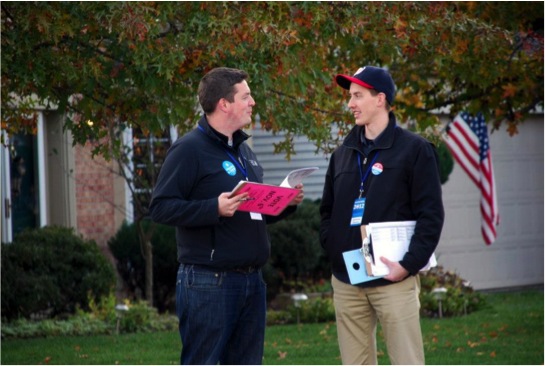
For campaigners, they’re hugely exciting – they engage people in politics and they’re opportunities to shape the agenda for the next government.
With just 120 days or so to go until the next UK General Election, there is a huge amount that we don’t know about what the outcome will be on May 7th.
That’s a huge opportunity and challenge for campaigners, we could get another Coalition Government, we don’t know which parties will end up in the TV debates, and what will happen in Scotland, with UKIP and the Green Party.
At the same time, election campaigns are getting more and more sophisticated, with parties using micro-targeting to reach specific groups, and social media working alongside the traditional ground game (think people knocking on doors) and air game (think TV news headlines).
For campaigners preparing for the election in May there are 7 things you need to be thinking about.
1 –Remember Charities can be political but not party political
Its too easy to think of politics as something that is just about different parties, but it’s not, politics is about the choices societies make and we have a stake in them being the right choices – including challenging vested interests.
If it wasn’t for campaigners engaging in politics, we wouldn’t have an arms trade treaty, equal marriage, climate change act, and much more.
Thanks to the Lobbying Act there is lots of talk about if charities should get involved in politics, but the short answer is yes.
As charities, you can’t engage in party politics, that is supporting one candidate over another, or providing an endorsement to one but not another, but we can, indeed we’re encouraged to engage in politics.
As we get ready for May, every campaigner should check out the guidance from the Electoral Commission on the Lobbying Act and the Charity Commission (Bond also has some helpful guidance) but that shouldn’t stop you from campaigning.
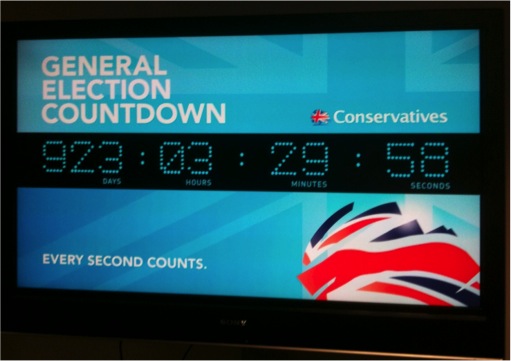
2 – Start now
Walk into the HQ of all of the main parties and you’ll see countdown clocks on their walls. For them the election has already started, and it’s got a fixed deadline – 10pm on May 7th, the point when polls close and nothing else can be done.
At the moment, in most constituencies’ candidates from any of the parties that hope to have a chance of winning will have been selected. For those candidates the most precious commodity they have is time, and as they get closer to the election, they’ll be thinking more and more about how they use their time to ensure they’re speaking to voters. Right now, candidates are busy, but not as busy as they will be in a few weeks time.
Come the ‘short’ campaign, which starts on 30th March, candidates are moving from one event to other, and they’re already starting to plan now for then, getting going now means your campaign has a chance of establishing itself before its just another event or activity in an already busy day.
3 – Everything is Local
There are few better ways of getting a sense of what people are thinking about than knocking on the doors as part of a party canvass, and as much as I’d like the top issues to be global poverty, climate change and world peace. More often than not its parking, poo, potholes, pavement and flytipping or welfare issues – housing, immigration, benefits. Occasionally global issues, but they’re rare.
For any campaign that means making your issues local as well, that could be making connections to local figures or events, ensure your statistics are localised or finding local figures to speak out in support of your issue.
Whatever you can do to demonstrate the breadth of local support for you campaign the better. Remember most candidates are thinking about events to attend alongside two axis the likelihood of those present actually voting and the likelihood of someone in the room voting for them, so make sure
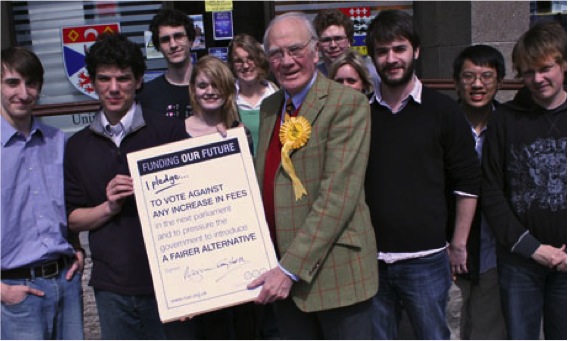
4- Make it Easy
Most candidates are keen to engage, they want to meet with voters, but remember they are time poor, so make it easy for them to engage with you and also their office staff. Behind ever candidate is a team who will be working hard and often making the decision about what events the candidate does and doesn’t attend.
Provide candidates with something in return for engaging with your campaign, the opportunity to meet local voters, a photo they can send to the local paper or thanks on twitter.
Also think about the medium of your message, most candidates will tell you that they’re already being inundated with emails and briefing papers, so what about video messages or infographic.
Finally, think about how they can really support your campaign – what can they actually do. Don’t ask a candidate to vote a particular way in Parliament if they’re not (yet) an MP.
5 – If they won’t come to you, go to them
One of the exciting thing about the upcoming election is I’m expecting more platforms that ever before to ask candidates the questions you want.
As well a the traditional hustings, often organised by local churches, this election most candidates are on twitter and looking to engage, local papers will run election specials, the growth of online localised communities holding ‘ask the candidate’ discussions or raising it when someone comes to knock on your doorstep. Whatever you can ‘get on the record’ now could invaluable come May 8th.
Heading into May, watching how parties respond to pledges is going to be interesting. Lots of campaigns ask candidates to sign pledge to show their support for an issue. It can an effective tool, but one I suspect many candidates will now approach with caution, especially as the possibility of a coalition government means MPs can be even less certain about what they can promise.
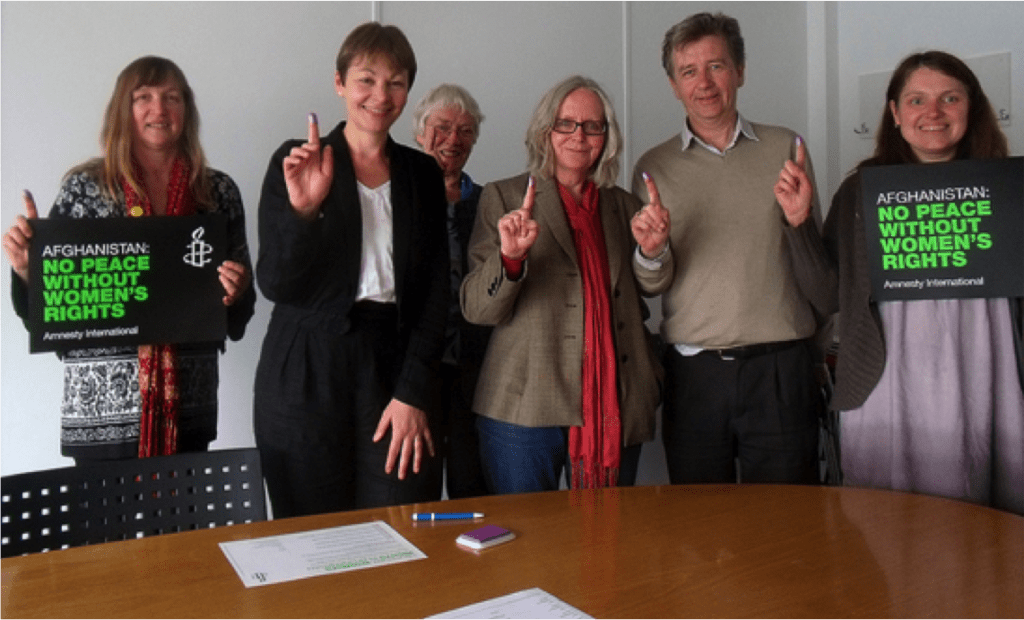
6 – Plan for May 8th
The election may be over, but the hard work for whoever is elected has just begun. Be ready to follow up with those who’ve been elected, politicians are often accused of only appearing near an election but can the same be said of campaigners?
Offer to come to meet with them to brief them on the issue, write to them, reminding them of what the said in the campaign and don’t overlook getting in touch with the candidates that weren’t successful – remember that they might be candidates in another election.
7 – Vote
I hope that most campaigners vote. I have a rule on election day, that you can’t show up to help get out the vote if you’ve not already voted. If we want to participate in campaigning, we need to vote. If your not sure you’ll be in your constituency on election day, sign up for a postal vote here.
Read, Reflect, Get a Mentor, Plan to Rest – 4 resolutions to make your a better campaigner in 2016
Originally posted in January 2015 but still relevant for 2016!
I’m terrible at keeping new year resolutions (if you want a campaigner who takes them very seriously check out Oxfam’s Al Kinley), but I’m a big fan of using the start of a new year to try to build new habits.
So as you get back into the office here are a few thoughts about steps that you could take to be a better campaigner in 20156.
1 – Read. A wise person once said to me that ‘leaders are readers’ its a maxim that’s stuck with me, and is part of the motivation for this blog.
In20156, make time to read about campaigns that are winning, trends that will impact your campaigning (Mobilisation Lab is a good place to start (and hopefully this blog)), what’s going on in politics (as a start sign up for daily emails from Labour List, Conservative Home, Lib Dem Voice plus Times RedBox) and be inspired by campaigners from the past.
But don’t just read things you agree with, take a moment to follow blogs and read newspapers that put alternative perspectives across. Don’t assume that everyone thinks the same as you and your colleagues, they don’t. Believe it or not, you could be a better campaigner by reading the Daily Mail.
2 – Reflect. When I started my new job in July, I penciled in my diary to take the forth Friday afternoon of each month to escape my desk and spend a few hours reflecting on what was working and wasn’t working. It hasn’t happened, although I’m going to try again in20156 with a less ambitious fortnightly lunch slot!
In campaigning, it can often feel like a luxury to take an hour or two to reflect and review on the last week, fortnight or month, but research shows that reflecting on performance actually improves your work. Why not start the year by booking in 30 minutes every 2 weeks to reflect on the following questions;
- What is your campaign doing well and what should you continue to do?
- What is your campaign doing ‘okay’ or badly and what can it improve?
- In what ways has your understanding about the situation deepened or changed?
- What have your learnt in the last fortnight? What areas are you being stretched in?
3 – Get a mentor. I’ve really valued those who’ve invested time in helping me be a better campaigner. I’ve found meeting with someone on a regular basis, about once every 4 to 6 weeks for an hour or so over coffee, has really helped me in my career. I find a mentor is someones brain I can mine for ideas, someone who can help me see the bigger picture or coach me through a particular challenge I’m facing.
It can feel intimidating trying to identify a mentor, it could be someone more senior in your organisation (probably in a different team), a campaigner you admire or someone working in a related area you’re keen to deepen your experience in. Start out by suggesting you trial it for 3 months and take it from their, you’ll be amazed that people like to say yes when you ask them
4 – Plan to Rest. You might feel rested after a Christmas break with a few long lie-ins and quiet days, but book your next break now, and make a strategy for how your going to switch off from your work over the next year. We need you to be involved in the work of delivering social change for at least the next 12 years, not just the next 12 month, and sadly too many of us burnout. I love these resources from the team at Plan to Thrive, I can’t commend this article from Rockwood Leadership enough on how to develop good habits to avoid burnout and I’m a big fan of encouraging everyone to take a retreat.
14 great reads for campaigners from 2014
Settle in with a cup of tea, here are 14 great reads (in a rough order of how much I enjoyed them) that I’ve shared during 2014 that a worth a read.
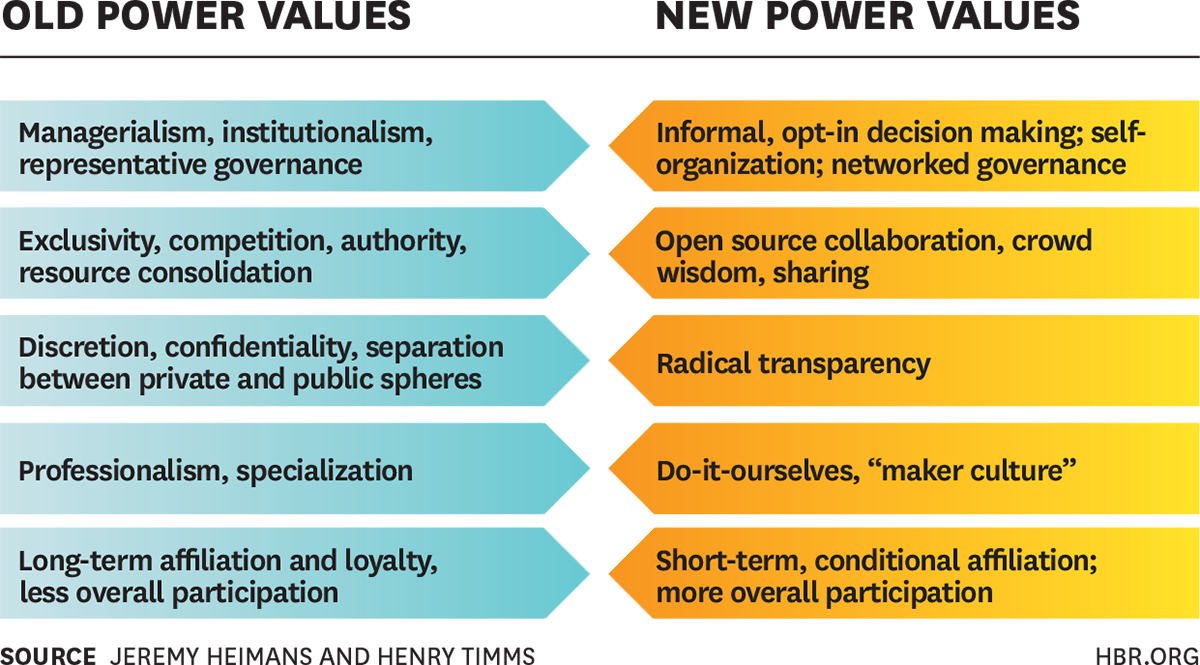
1. Understanding New Power – brilliant from Jeremy Heimans and Henry Timms on how the world is changing. A must read (great summary in the graphic above).
2. Changing Trends: New Power, Neuro-Campaigning and Leaderless Movements – just love this paper on key campaigning trends from Hannah and Ben.
3. Purpose Driven Campaigning – 40 key principles for growing social movements drawn from Purpose Driven Church.
4. When the pillars fall — How social movements can win more victories like same-sex marriage – brilliant look at how same-sex marriage advocates in the US build a movement to win.
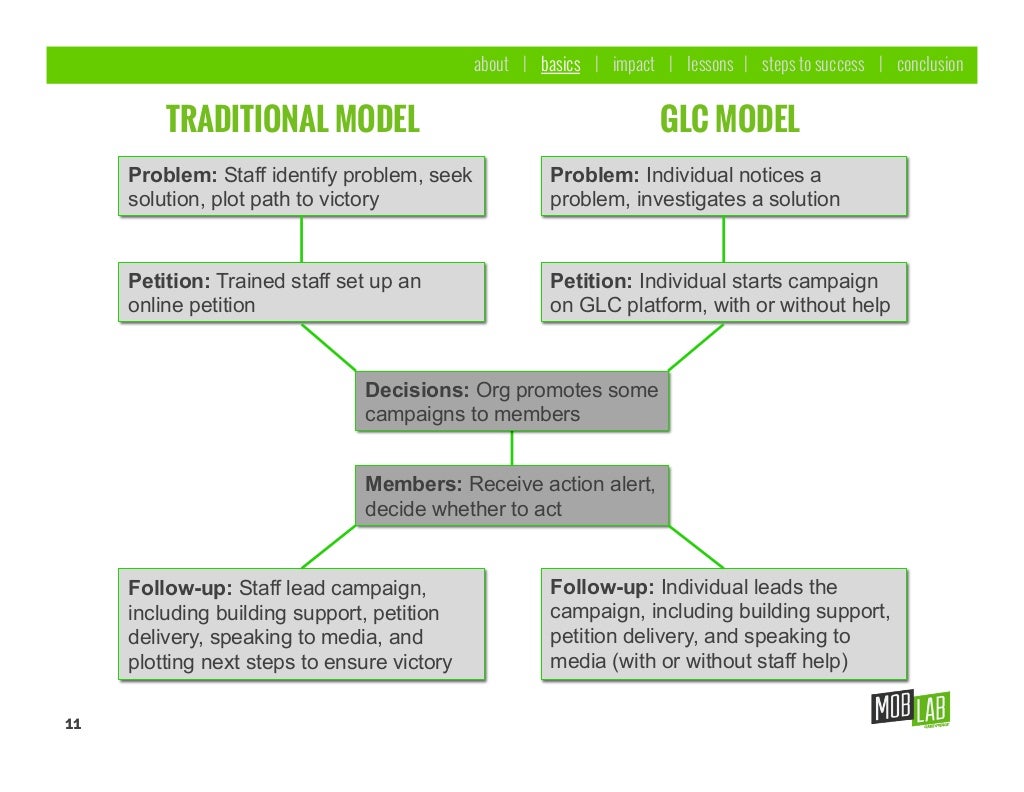
5. Grassroots-led Campaigns: Lessons from the new frontier of people-powered campaigning – brilliant MobLab report full of wisdom and insight of the people at the cutting edge of grassroots-led campaigns (GLC model in the graphic above). Basically anything MobLab writes is brilliant.
6. From fired up to burnout: 7 tips to help you sustain a life committed to social justice – offered without comment.
7. 6 things today’s breakout campaigns get right – great insight from the always brilliant Jason Mogus
8. “More of an art than a science”: Challenges and solutions in monitoring and evaluating advocacy – also enjoyed this by Jim Coe.
9. Stonewall’s secrets of successful charity lobbying – top tips from one of the best (also learning from Greenpeace here).
10. From Petitions to Decisions – how change.org is continuing to innovate.

11. Inside the Cave – a look at the digital and technology behind the Obama 2012 campaign (and here is more on how the campaign used twitter)
12. The Art of Coalition Campaigning – brilliant set of reflections from Ben Niblett.
13. 14 lessons from the Scottish referendum – useful reflections from the UK political event of the year (more here)
14. Rage Against the Machine – Lessons from Guzzardi–Berrios Race – how a 26-year-old former journalist organised to get elected in Chicago. Great lessons about working with the grassroots (and here on how to lose your seat when your a high-profile US politician).
5 lessons from the AV campaign
Paul Waugh has a great article on ‘Who won the AV digital war’. It’s full of interesting learning about what worked and what didn’t.
In short, the Yes campaign (the link is to the Labour YES site as the cross-party site has already been taken down) tried to build from the grassroots, based on the fact that they inherited a list of 150,000 people who were involved in campaigns like Unlock Democracy. It put it’s effort into converting this online support into offline activities, like getting activists to organise street stalls and events (of which 3,000 were organised). I guess by extension it was also hoping that its messages would cascade down from activists to their friends through social networks.
The No2AV campaign didn’t inherit an email list and focused on buying advertising on high-profile websites, reportedly spending the most of any campaign in UK political history on the day of the ballot (the exact figures will be released in the coming weeks when the final spending figures are released) and pushing people to its sites and You Tube page, which worked as the NO campaign registered almost twice as many views of its YouTube channel. According to Waugh a decision was made not to engage on twitter and also placed a greater focus on using text messages as a tool to mobilise supporters to attend events.
 Clearly the result of the referendum wasn’t simply about the success or failure of the digital campaigns (you can read more about the politics of the campaign here) but I still think it has some interesting lessons for NGO campaigns especially as Waugh suggests ‘From its hardline attack ads to its press operation and its mass bombardment approach, the No2AV campaign most felt like a mainstream political party. With its activism and social engagement, not surprisingly perhaps, the Yes campaign most looked like an NGO’
Clearly the result of the referendum wasn’t simply about the success or failure of the digital campaigns (you can read more about the politics of the campaign here) but I still think it has some interesting lessons for NGO campaigns especially as Waugh suggests ‘From its hardline attack ads to its press operation and its mass bombardment approach, the No2AV campaign most felt like a mainstream political party. With its activism and social engagement, not surprisingly perhaps, the Yes campaign most looked like an NGO’
1. Digital media needs to be at the heart of any campaign – Both campaigns put digital media at the heart of their approaches by ensuring the appropriate lead staff attended key strategy meetings. Waugh says ‘MessageSpace’s Jag Singh, an early appointment as Director of Digital Comms for No2AV, was ’embedded’ in the highest level of the campaign, attending all of their 8am morning meetings for example’ and suggests that same was true of the Yes campaign.
2. You can raise money from online campaigning with the right ask – The Yes campaign generated £250,000 from small donations (the average was £28) in the course of the campaign. A good example of a timely ask to the right audience can raise money as well as lead to activism.
3. Let’s not forget mobile phones as an organising tool – It’s interesting to note the use of this by the No2AV team to mobilise supporters. A few weeks ago I heard that research has shown that most text messages are read within 15 minutes, the same clearly can’t be said of emails where a 10% open rate is considered ‘good’. Should NGO campaigns be investing more in collecting mobile numbers that can be used to inform activists of key events or actions?
4. You need to reach out beyond the usual suspects – Was one of the reasons that the No2AV approach work so well was that in buying on-line marketing it reached beyond the usual suspects on the day of the election, whereas Yes campaign activists were speaking in an ‘echo chamber’ where they were simply sharing their tweets and messages to friends with similar views who were already inclined to vote Yes. One status update on my Facebook wall perhaps summarises this problem well ‘if my Facebook feed is anything to go by, the Yes vote is in the bag. But then, I don’t think I have a very proportionate representation’
5. Decide what to do with the data afterwards before the event – Waugh highlights a problem common to many in coalitions, both campaigns have built significant e-lists but it isn’t clear what to do with that data now. A good reminder of the need to discuss this before your build your list.
Do you agree? Did the politics of the situation mean the digital strategy wasn’t going to make a difference either way?
Can we ever hope to influence Beijing?
 China officially became the second biggest economy in the world last month overtaking Japan for the first time, and while the influence of China over most international processes has been clear for a long time, can we ever expect to influence the Chinese government?
China officially became the second biggest economy in the world last month overtaking Japan for the first time, and while the influence of China over most international processes has been clear for a long time, can we ever expect to influence the Chinese government?
Both Oxfam and Greenpeace must believe so, as they’ve expanded out of Hong Kong to open offices in Beijing and include advocacy as one of the priority activities that they’re involved.
However putting the words ‘China+advocacy’ or ‘Influencing Chinese government’ doesn’t come up with many useful results.
No doubt that’s partly down to the lack of documents in English and the unique political system in the country. But even so the material about doing so seems to be very scarce, so I hope that this post will be an opportunity to learn from others about how organisation have gone about starting to think about the opportunities.
Here are two example of advocacy in or towards China that I’m aware about.
What others can you add? And what, if anything can we learn from them?
Greenpeace East Asia – Last year, Greenpeace alongside ad-agency Ogilvy turned 80,000 pairs of used chopsticks into trees which were displayed in Beijing in an attempt to highlight the impact of using disposable chopsticks was having on the countries forests, and encouraged people to sign a pledge to carry around their own pair of chopsticks. However, the focus of this campaign was on raising public awareness and personal action rather than political action.
Avaaz – In 2007/08 the online campaign movement repeatedly asked its supporters to send messages to the Chinese government over the situation in Burma. It collected an impressive 800,000 names on its petition which called for an end of the oppressive crackdown on demonstrators, including placing an advert in the Financial Times asking ‘What Will China Stand For?‘.
For me, these two examples raise as many questions as they answer. Do our traditional models of ‘northern’ advocacy need to change if we want to be effective in China? Is ‘quiet’ advocacy more likely to work than public mobilisation? What’s the role of the international media? Does China worry about the way its perceived by others around the world?
#SaveOurForest – a campaign reader

Put a note against Thursday 17th February in your diary, as it marks an important moment for campaigning in the UK. The coming of age of 38 degrees.
Today, the online campaigning movement celebrated as it notched up its most high-profile victory yet, the government make a U-turn and abandons its plan to sell of the forests (watch the announcement to Parliament here).
Lots has already been written about the campaign, and I don’t think I can add much at present, here is a reader of some of the top articles which explore how the campaign unfolded and the impact it’s had.
1. The Guardian explores the important role that social media played in the campaign in Forest sell-off: Social media celebrates victory
2. Johnny Chatterton, from 38 degrees writes for Left Foot Forward about the size of the campaign, with his boss, David Babbs, Executive Director saying ‘Forest sell-off U-turn is a victory for people power‘
3. Chris Rose wrote last week about how ‘Clicktivism By-passes Inside Track To Harry Potter Forest‘ and also the roots that this campaign had in previous battles for forests around the country.
4. Jonathan Porritt criticised the larger environmental NGOs by not supporting the campaign of ‘collective betrayal‘ on his blog, while this blog argued that the campaign had highlighted some of the challenges large NGOs faced in responding to an issue with the agility an organisation like 38 degrees can.
5. The Sunday Telegraph ran many articles, demonstrating the broad support the campaign had ‘Save our forests, say celebrities and leading figure’ something that was clearly important in the victory.
6. But not everyone has been so kind, with Anthony Barnett at Open Democracy, suggesting that 38 degrees shouldn’t take all the credit for the campaign victory, following up on an earlier post challenging them not to compete but campaign with others.
7. But the last word picture should go to cartoonist Steve Bell in today’s Guardian.
What other articles have you read that help to explain the story behind the campaign? Why did this campaign work when so many others haven’t?
When a NGO admits it’s wrong. WWF and it’s (non) involvement in the Save Our Forests campaign
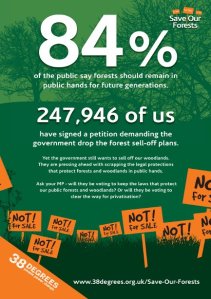 It’s not often you see a big NGO come out in public and admit that they got something wrong.
It’s not often you see a big NGO come out in public and admit that they got something wrong.
So it’s great to see WWF put out a statement today effectively apologising for its lack of public action and clarifying its stance on UK forest sell-off in response to some harsh criticism it’s received in the press this week.
It’s a spat that started in the Guardian on Monday when environmentalist Jonathan Porritt accused major charities, including WWF, RSPB and the National Trust of “collectively betrayed” for their failure to support the grassroots campaign that has grown in the recent weeks to halt the sale of English forests, while Polly Toynbee put the boot in on Tuesday accusing green groups of ‘keeping their heads down over selling off forests’.
Today, WWF have responded with an excellent statement on their website confessing that they should have done more from the start.
Porrit stated “There have been no statements, no mobilisation of its massive membership, no recognition that this is an absolutely critical issue for the future wellbeing of conservation in the UK. Nothing”.
Suggesting that the lack of action had “made themselves look foolish and irrelevant as one of the largest grassroots protests this country has seen for a long time grows and grows without them – indeed, despite them.”
There is no doubt that the campaign mounted by 38 degrees and others has gathered a huge amount of momentum in a short time, it’s petition has just gone over the half a million mark.
Perhaps most interestingly, it feels like it’s not only the ‘usual suspects’ who are signing on. A non-campaigning friend of mine posted the link to the petition on Facebook tonight encouraging people to sign, and the Observer reported of the opposition of many land owners last weekend.
So I’m impressed to see the response from WWF today, who write of the statement that ‘It’s fair to say this is a bit overdue as loads of you have asked us what we’re doing about the proposed government sell-off (or long-term leasing) of UK forests’
Going on to explain ‘Not having much of a history working on UK forests, we did most of our work behind the scenes and focused our public firepower on issues like illegal logging via our ‘What Wood You Choose?’ campaign. We are working with peers getting an amendment tabled in the House of Lords and had questions asked in parliament, but to be honest we did precious little in public’ (emphasis mine)
In time it might be right to ask if criticising environmental NGOs in such a public way was the right approach by Porritt? As an unnamed source in the original article says ‘Rule one of clever campaigning is that you don’t criticise members of your team, at least not in public’ and WWF say they’ve been working on this behind the scenes.
But for me this spat has once again highlights some of the challenges that the more ‘traditional’ NGOs need to address in their campaigning.
1. Agility
Movements like 38 degrees are so well placed, because they can respond within hours not days. They lack the restrictions of charitable status and often no desire for a seat at the table in ongoing consultation. Combine this with a phenomenal e-mail network mean that they can be ‘first to market’. The challenge that many ‘traditional’ NGOs face is that they’re not set up to turn around a response in the time that online campaigns like 38 degrees.
No doubt heated discussions have been happening at all the NGOs that Porritt choose to criticise (as you can see implied by the response from WWF), but the very nature of these organisations mean that multiple departments need to be involved and opportunities and risks needs to be carefully calculated, but that whole process takes time, and internal compromises often have to be negotiated. In this digital age waiting even 24 hours to respond or act can be too long.
2 – Collaboration
Within a day or so 38 degrees had already collected the first 50,000+ names on its petition, and then you have to ask how much value there is in starting a second competing petition. This for me is the second challenge are traditional NGO prepared to ‘brand’ and ‘profile’ aside and collaborate for the common good when situations like this arise?
Would the NGOs named be prepared to promote the 38 degrees petition assuming they agreed with the essence of what it was calling for?
On this regard I’ve got a huge amount of respect for WWF for saying in their statement ‘To their great credit, 38 Degrees organised a massive public response (sign here if you haven’t already)’ but no doubt that line will cause some anxiety in the organisation as supporters are encouraged to share their valuable data with others.
Collaboration is essential, and to do it well campaigners need to recognise the different roles and approaches needed for effective campaigns.
Save our Forests is no different, surely it’d be of huge value to have organisations with both years of experience in nature conservation joining the campaign and impressive contacts within Parliament to be involved. But to do that requires someone to initiate the collaboration, and in situations like this perhaps it’s not clear who that should be.
3. Accountability
Perhaps it wasn’t Porritt’s criticism and the Guardian articles that lead WWF to clarify their position. The statement from WWF certainly indicates that they’ve also been hearing complaints from supporters saying ‘The scale of passion around this issue has led to a lot of emails as to WWF’s role’.
This case seems to be another example of the increasingly complex relationship that organisations have with their supporters. The tools of collaboration and campaigning aren’t just in the hands of a few professionalised campaigners, they’re available to supporters to lobby the organisations they belong to. It also shows that many campaigners are active in more than one campaigning network.
So congratulation on an excellent response from WWF, a response that already seems to be yielding appreciation from supporters with one writing;
Thank you. As a WWF member and supporter of the Save Our Forests campaign, I’m very glad you’ve joined the campaign. The statement above is everything we could have hoped for.
Now I’m left wondering if we’ll see the National Trust and RSPB come out with a statement in recent days.
